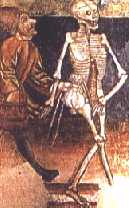![]() The
Ljubljanska cesta leads you out of Koper. After a drive of about
twelve kilometers, you will reach Rizana. Turn south (in the
direction of Socerga/Buzet) and follow the little road forking
towards the southeast until you reach the village of Hrastovlje.
The
Ljubljanska cesta leads you out of Koper. After a drive of about
twelve kilometers, you will reach Rizana. Turn south (in the
direction of Socerga/Buzet) and follow the little road forking
towards the southeast until you reach the village of Hrastovlje.
The most interesting sight in this tiny village of 140 inhabitants is the pretty fortified church from the 12th-13th centuries, which stands on a hill overlooking the community. The building, originally in Romanesque style, was fortified in the 16th century as a means of defence against the Turks. The inhabitants of the village were "defence peasants," so-called in the service of the House of Habsburg, which gave them free use of land and demanded no taxes from them. In exchange for this, the peasants had to defend the area if trouble was afoot. Since peasant dwellings at this time were built from wood, it was logical to fit the only stone building of the area for special defence tasks and to surround it with a wall. The church could not withstand a major army, but might hold oft marauding bands.
 Despite
being a fortified building, the interior of the Church of Sveti Trojstvo
(Holy Trinity) exudes a solemn atmosphere. It is decorated from top to
bottom with frescos showing biblical scenes and images of the medieval
world. The most interesting fresco is on the south wall and shows a Dance
Macabre. Its message: In the face of death all men are equal, whether pope,
emperor or beggar; how true, considering the devastating epidemics of the
Middle Ages.
Despite
being a fortified building, the interior of the Church of Sveti Trojstvo
(Holy Trinity) exudes a solemn atmosphere. It is decorated from top to
bottom with frescos showing biblical scenes and images of the medieval
world. The most interesting fresco is on the south wall and shows a Dance
Macabre. Its message: In the face of death all men are equal, whether pope,
emperor or beggar; how true, considering the devastating epidemics of the
Middle Ages.
In the barrel vaulting of the side aisles are several small scenes from peasant life, among them vine-harvesting. These frescos date from 1490 and were painted by Ivan of Kastav. He belonged to a circle of local artists, and his works can be seen in other places in Istria, including the parish church of Beram.
There are two dances of death in Istria, a region in former Yougoslavia. The oldest one is situated in the Croatian part of Istria, precisely in Beram. The second one lies in the Slovenian area, in Hrastovlje. In this little town there is a 12th century Trinity church adorned with many frescoes. Besides the dance of death, you can admire there several biblical scenes (the twelve Apostles, the Holy Trinity, the Three Magi, the creation of the world, the Passion etc.) The dance of death, discovered in 1950 and then properly restored, was painted by Jean de Kastav in 1490. It is different from other dances of death by the way its characters walk : they go from right to left, which is pretty unusual. Furthermore, the skeletons do not really dance ; they walk in procession towards a skeleton sitting on a Gothic chair, who takes the place of the usual narrator. The skeleton raises with his right hand the lid of a coffin ; a shovel and a hoe lie at his feet.
 Eleven
characters are involved in this pictorial dance of death, which has no text.
Beside the grave stand the pope, followed by the king, the queen, the
cardinal, the bishop, the monk, the burgher, the usurer, the young man, the
crippled, and finally a child jumping out of his cradle. The skeleton going
with the pope points out the final destination of all characters: the grave.
The ones that accompany the king, the cardinal, the monk and the burgher
raise their right hand ; this gesture suggests a kind of salute. Strangely,
only two skeletons (the bishop's and the cripple's) are carrying
accessories. Notice the funny gesture of the usurer, who rummages in his bag
with his right hand while handing a purse to Death with his left. The usurer
is the only character that Death pulls by his clothes instead of his hand.
He does not understand yet that his torturer cannot be bribed : Death is
incorruptible and kills the rich as well as the poor.
Eleven
characters are involved in this pictorial dance of death, which has no text.
Beside the grave stand the pope, followed by the king, the queen, the
cardinal, the bishop, the monk, the burgher, the usurer, the young man, the
crippled, and finally a child jumping out of his cradle. The skeleton going
with the pope points out the final destination of all characters: the grave.
The ones that accompany the king, the cardinal, the monk and the burgher
raise their right hand ; this gesture suggests a kind of salute. Strangely,
only two skeletons (the bishop's and the cripple's) are carrying
accessories. Notice the funny gesture of the usurer, who rummages in his bag
with his right hand while handing a purse to Death with his left. The usurer
is the only character that Death pulls by his clothes instead of his hand.
He does not understand yet that his torturer cannot be bribed : Death is
incorruptible and kills the rich as well as the poor.
All rights reserved 1998 - Patrick Pollefeys for the text